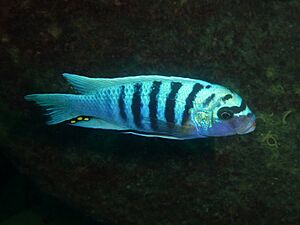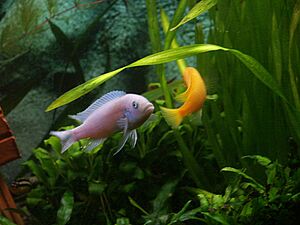Zebra mbuna facts for kids
Quick facts for kids Zebra mbuna |
|
|---|---|
 |
|
| Male zebra mbuna | |
| Conservation status | |
| Scientific classification | |
| Synonyms | |
|
The zebra mbuna (Maylandia zebra) is a cool type of cichlid fish. It lives only in Lake Malawi in Africa. This fish can grow to be about 11.3 centimeters (4.4 inches) long. It eats a special kind of food called aufwuchs. This is a layer of algae and tiny creatures that grows on rocks. The female zebra mbuna is a mouthbrooder. This means she keeps her eggs safe in her mouth for about three weeks. You might sometimes see this fish in pet stores, as it is popular for aquariums.
Contents
What They Look Like
The zebra mbuna has one fin on its back called a dorsal fin. It has 16 to 19 stiff spines and 7 to 10 soft rays. Its anal fin, on its belly, has 3 to 4 spines and 6 to 9 soft rays. This fish can grow up to 11.3 centimeters (4.4 inches) long.
Male zebra mbuna fish have different colors depending on where they live. Some males have a dark head, throat, and belly. Others have a blue head, a whitish throat, and a grey-blue belly. In both cases, their bodies are bright blue with up to eight grey or black stripes. Their dorsal fin is blue. The anal fin can be blue or grey, with one to five orange or yellow spots.
Female zebra mbuna fish can come in two different color forms. This is called being polymorphic. One type of female has a pale brownish-grey head and body. Her fins are also similar in color. Her pectoral fins have grey rays and clear parts. Her black pelvic fins have white edges. The other type of female has a brown throat. Her head and body are dark brown to black, with blue highlights. Her dorsal and tail fins are brown-black. Her anal fins are also brown-black, but they have yellow spots on their edges. Her pectoral fins have brown rays and clear parts. Her black pelvic fins also have white edges.
Where They Live
The zebra mbuna lives only in Lake Malawi in Africa. You can find them in rocky areas. They live in places where there is sand and also where the rocks are bare. They usually live at depths between 6 and 28 meters (20 to 92 feet).
What They Eat
Zebra mbuna fish mostly eat aufwuchs. This is a community of algae and tiny organisms that stick to rock surfaces. They also eat tiny animals called zooplankton and small invertebrates.
Their mouth is at the tip of their snout and can move a lot. They have two-pointed teeth at the front and three-pointed teeth spaced out behind. To eat, they hold their body sideways to a rock. They press their mouth against the surface. Then, they open and close their mouth many times. This action scrapes off the loose aufwuchs, which they then swallow.
Reproduction and Life Cycle
The zebra mbuna is a maternal mouth brooding cichlid. This means the mother fish keeps her eggs and young babies safe inside her mouth. She holds them there for 18 to 24 days. During this time, she cannot eat, so she loses weight. When the young fish, called fry, are big enough, she lets them out into the water. They quickly find places to hide.
Scientists have studied how male zebra mbuna choose their mates. They found that a male fish often prefers a female whose colors are similar to his own mother's colors. His past experiences did not seem to change his choice.
Zebra Mbuna as Pets
These fish are quite popular to keep in home aquariums.



